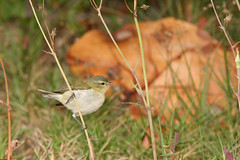"Those who cannot remember the past are condemned to repeat it."
~ George Santayana (1905) Reason in Common Sense, volume 1 of The Life of Reason
 The Passenger Pigeon, once the most common bird in North America, went into a catastrophic decline in numbers and then extinction by 1914.
The Passenger Pigeon, once the most common bird in North America, went into a catastrophic decline in numbers and then extinction by 1914.
Similar in looks to the Mourning Dove, they lived in enormous flocks and during migration it was possible to see up to a billion birds taking several days to pass. Some reduction in numbers occurred as a result of loss of habitat when the Europeans started settling further inland.
Over-hunting also played a large part in their destruction. Conservationists were able to get a bill passed in the Michigan legislature making it illegal to net pigeons within two miles of a nesting area, but the law was weakly enforced.
One of the last large nest sites of passenger pigeons was at Petoskey, Michigan, in 1878. Over 50,000 birds were killed each day and the hunt continued for nearly five months. In 1896, the final flock of 250,000 were killed by American sportsmen knowing that it was the last flock of that size.
The last Passenger Pigeon, named Martha, died at the Cincinnati Zoo on September 1, 1914. Within a few decades, the once most numerous bird on Earth was gone. However, the extinction of the passenger pigeon aroused public interest in the conservation movement and resulted in new laws and practices which have prevented many other species from going extinct.
Wild Birds Unlimited is deeply committed to educating the public about the importance of understanding our environment and preserving our natural wildlife habitats. All Wild Birds Unlimited stores donate a portion of proceeds to support education, conservation and wildlife viewing projects at wildlife refuges, parks, sanctuaries and nature conservancies throughout North America.
We’ve also developed many partnerships with organizations that support its core mission of bringing people and nature together. For a link to these partners click here: http://www.wbu.com/partners/index.html
~ George Santayana (1905) Reason in Common Sense, volume 1 of The Life of Reason
 The Passenger Pigeon, once the most common bird in North America, went into a catastrophic decline in numbers and then extinction by 1914.
The Passenger Pigeon, once the most common bird in North America, went into a catastrophic decline in numbers and then extinction by 1914.Similar in looks to the Mourning Dove, they lived in enormous flocks and during migration it was possible to see up to a billion birds taking several days to pass. Some reduction in numbers occurred as a result of loss of habitat when the Europeans started settling further inland.
Over-hunting also played a large part in their destruction. Conservationists were able to get a bill passed in the Michigan legislature making it illegal to net pigeons within two miles of a nesting area, but the law was weakly enforced.
One of the last large nest sites of passenger pigeons was at Petoskey, Michigan, in 1878. Over 50,000 birds were killed each day and the hunt continued for nearly five months. In 1896, the final flock of 250,000 were killed by American sportsmen knowing that it was the last flock of that size.
The last Passenger Pigeon, named Martha, died at the Cincinnati Zoo on September 1, 1914. Within a few decades, the once most numerous bird on Earth was gone. However, the extinction of the passenger pigeon aroused public interest in the conservation movement and resulted in new laws and practices which have prevented many other species from going extinct.
Wild Birds Unlimited is deeply committed to educating the public about the importance of understanding our environment and preserving our natural wildlife habitats. All Wild Birds Unlimited stores donate a portion of proceeds to support education, conservation and wildlife viewing projects at wildlife refuges, parks, sanctuaries and nature conservancies throughout North America.
We’ve also developed many partnerships with organizations that support its core mission of bringing people and nature together. For a link to these partners click here: http://www.wbu.com/partners/index.html
Related Articles:
- Why should we care about birds? http://goo.gl/4iD8a
- Who Bird Watches http://goo.gl/vX9j5
- Why is the Dove a Symbol of Peace? http://t.co/Br4EnlB
- War Pigeon Remembered http://t.co/5yiXSNS
- Project Passenger Pigeon http://www.passengerpigeon.org/index.html




















.jpg)

























